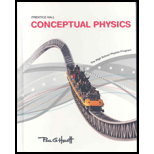
Concept explainers
The device used to measure the relative masses of ions of isotopes.
Explanation of Solution
Introduction:
The relative masses of the ions of the isotopes can be found by the atomic masses of the isotopes because the
The relative masses of the isotopes in a sample compared by the charge to mass ratio of the ion. The device in which the relative masses are found is called the mass spectrometer. The mass spectrometer uses a magnetic field to deflect the ions into circular arcs. The speed of all ions of isotope are same but their masses are different. The ion of heavier mass deflects less but lighter ion deflects more in the magnetic fields. The radius of curved path for heavier ion is less and more for lighter ion.
The relative masses of the ions of isotopes can be found by comparing the radius of curved path of ions in mass spectrometer.
Conclusion:
Thus, the mass spectrometer is used to measure the relative masses of ions of isotopes.
Chapter 40 Solutions
Conceptual Physics: The High School Physics Program
Additional Science Textbook Solutions
Concepts of Genetics (12th Edition)
Microbiology with Diseases by Body System (5th Edition)
Organic Chemistry (8th Edition)
Chemistry: An Introduction to General, Organic, and Biological Chemistry (13th Edition)
Physics for Scientists and Engineers: A Strategic Approach, Vol. 1 (Chs 1-21) (4th Edition)
Biology: Life on Earth (11th Edition)
- ! Required information The radius of the Moon is 1.737 Mm and the distance between Earth and the Moon is 384.5 Mm. The intensity of the moonlight incident on her eye is 0.0220 W/m². What is the intensity incident on her retina if the diameter of her pupil is 6.54 mm and the diameter of her eye is 1.94 cm? W/m²arrow_forwardRequired information An object is placed 20.0 cm from a converging lens with focal length 15.0 cm (see the figure, not drawn to scale). A concave mirror with focal length 10.0 cm is located 76.5 cm to the right of the lens. Light goes through the lens, reflects from the mirror, and passes through the lens again, forming a final image. Converging lens Object Concave mirror 15.0 cm -20.0 cm- 10.0 cm d cm d = 76.5. What is the location of the final image? cm to the left of the lensarrow_forward! Required information A man requires reading glasses with +2.15-D refractive power to read a book held 40.0 cm away with a relaxed eye. Assume the glasses are 1.90 cm from his eyes. His uncorrected near point is 1.00 m. If one of the lenses is the one for distance vision, what should the refractive power of the other lens (for close-up vision) in his bifocals be to give him clear vision from 25.0 cm to infinity? 2.98 Darrow_forward
- ! Required information Assume that the magnifier is held close to the eye. Use the standard near point of 25.0 cm to find the angular magnification. An insect that is 4.10 mm long is placed 10.3 cm from a simple magnifier with a focal length of 13.0 cm. What is the angular magnification?arrow_forward2arrow_forward3arrow_forward
- Imagine you are out for a stroll on a sunny day when you encounter a lake. Unpolarized light from the sun is reflected off the lake into your eyes. However, you notice when you put on your vertically polarized sunglasses, the light reflected off the lake no longer reaches your eyes. What is the angle between the unpolarized light and the surface of the water, in degrees, measured from the horizontal? You may assume the index of refraction of air is nair=1 and the index of refraction of water is nwater=1.33 . Round your answer to three significant figures. Just enter the number, nothing else.arrow_forwardDeduce what overvoltage is like in reversible electrodes.arrow_forwardpls help on thesearrow_forward
- pls help on thesearrow_forward20. Two small conducting spheres are placed on top of insulating pads. The 3.7 × 10-10 C sphere is fixed whie the 3.0 × 107 C sphere, initially at rest, is free to move. The mass of each sphere is 0.09 kg. If the spheres are initially 0.10 m apart, how fast will the sphere be moving when they are 1.5 m apart?arrow_forwardpls help on allarrow_forward
 College PhysicsPhysicsISBN:9781305952300Author:Raymond A. Serway, Chris VuillePublisher:Cengage Learning
College PhysicsPhysicsISBN:9781305952300Author:Raymond A. Serway, Chris VuillePublisher:Cengage Learning University Physics (14th Edition)PhysicsISBN:9780133969290Author:Hugh D. Young, Roger A. FreedmanPublisher:PEARSON
University Physics (14th Edition)PhysicsISBN:9780133969290Author:Hugh D. Young, Roger A. FreedmanPublisher:PEARSON Introduction To Quantum MechanicsPhysicsISBN:9781107189638Author:Griffiths, David J., Schroeter, Darrell F.Publisher:Cambridge University Press
Introduction To Quantum MechanicsPhysicsISBN:9781107189638Author:Griffiths, David J., Schroeter, Darrell F.Publisher:Cambridge University Press Physics for Scientists and EngineersPhysicsISBN:9781337553278Author:Raymond A. Serway, John W. JewettPublisher:Cengage Learning
Physics for Scientists and EngineersPhysicsISBN:9781337553278Author:Raymond A. Serway, John W. JewettPublisher:Cengage Learning Lecture- Tutorials for Introductory AstronomyPhysicsISBN:9780321820464Author:Edward E. Prather, Tim P. Slater, Jeff P. Adams, Gina BrissendenPublisher:Addison-Wesley
Lecture- Tutorials for Introductory AstronomyPhysicsISBN:9780321820464Author:Edward E. Prather, Tim P. Slater, Jeff P. Adams, Gina BrissendenPublisher:Addison-Wesley College Physics: A Strategic Approach (4th Editio...PhysicsISBN:9780134609034Author:Randall D. Knight (Professor Emeritus), Brian Jones, Stuart FieldPublisher:PEARSON
College Physics: A Strategic Approach (4th Editio...PhysicsISBN:9780134609034Author:Randall D. Knight (Professor Emeritus), Brian Jones, Stuart FieldPublisher:PEARSON





